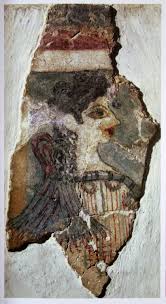King Minos Labyrinth : Minotaur in Ancient Greek Mythology

Built by the masters of Crete from around 1700 BC, the palace of Knossos, with its countless interlocking rooms and corridors, may have inspired the legend of the labyrinth.
The minotaur labyrinth story
Minos, King of Crete and son of Zeus and Europa, asks the architect Daedalus to build a structure in order to enclose the Minotaur, a creature half man, half bull, fruit of the loves of his wife, Queen Pasiphae, and the god Poseidon disguised as a bull. Daedalus imagines the Labyrinth complex, from which no one can find the exit.
Minos having defeated Athens, the enslaved city must pay an annual tribute of 7 young men and 7 young girls, all to be sacrificed to the Minotaur, until the day when the Athenian hero Theseus slays the monster. Thanks to the thread unwound by Ariadne, daughter of Minos, the winner of the Minotaur manages to find the exit of King Minos Labyrinth.
Daedalus, punished by Minos for helping Ariadne, is in turn locked in the labyrinth with his son Icarus but they manage to escape by making wings with feathers and wax.
A capital discovery that joins greek mythology
In 1894, British archaeologist Sir Arthur Evans found much evidence of Minoan civilization beneath Greek and Roman remains. From 1900, he undertook the clearing of the Palace of Knossos, which probably originally had 1,300 rooms. Today there are 800 of them, distributed on either side of a beautiful paved courtyard: to the west, the king's ceremonial apartments, the throne room, and the worship room. To the east, the queen's apartments and the servants' quarters. To the north, the residential district. In fact, the Palace of Knossos alone constitutes a miniature city.
The hypothesis according to which this complex architecture would have inspired mythological accounts on the Labyrinth is probable, especially as many frescoes (such as the so-called Bull-Leaping Fresco, today in the Heraklion Museum) and sculptures representing bulls were found there.
The refined comfort of living in Knossos
Places of worship, the queen's boudoir or bathroom, the entire palace is marked by a concern for refined comfort. Built between thick walls, the rooms are, thanks to their openings arranged in a baffle, protected from cold drafts in winter, heat in summer and lit by skylights.
The palace resembles the homes of the wealthy inhabitants of that time, but it stands out for its size as it reaches, in certain places, up to 5 floors.
A charm and elegance that contradict the labyrinth legend

The Palace of Knossos is striking with its extraordinary elegance. A set of columns extends to all elements of the construction. Originally made from an overturned and painted tree trunk, these columns have been reconstructed in stone.
The charm of the place is also due to the decor, in bright and cheerful tones, which entirely covers the walls. Objects, pets or wild animals and men come alive there in the image of this woman with the keen eye, the upturned nose, the free hair, who has been baptized "La Parisienne" or the "Minoan Lady", as her allure is flirtatious ...
Minoan Crete
The remains found, which date from the 2nd millennium BC, revealed a brilliant civilization which used a pictographic writing and enjoyed a rich economy founded on the trade with the countries of the Mediterranean rim.
The history of this civilization is marked by brutal ruptures. Around 1750 BC, disaster strikes, probably in the form of an earthquake, which ravages the island. Crete is recovering quickly, the palaces are rebuilt, larger, more beautiful. Their walls are covered with paintings and frescoes, some of which represent everyday life.
Two hundred years later, a new earthquake, following an eruption of the volcano of Thera (now Santorini), once again destroys the palaces which are reconstructed with magnificence: the Minoan civilization reaches its peak.
But around 1450 BC, it suddenly disappears. This time, the disaster is not due to natural causes, but to invasions from Greece.
The labyrinth, a magic symbol
The labyrinth is an initiation par excellence, it leads to a central place which is the ultimate meeting place where man is confronted with himself. Caves with multiple rooms, shell designs… the labyrinth exists in its natural state. Very early on, man reproduces its shape and gives it a magical meaning.
3000 years old ancient mazes
The first truly evolved representation is found in a burial site dug 3000 BC near Luzzanas, Sardinia. One finds the labyrinth in Tintagel, Cornwall, engraved on megaliths between 1800 and 1400 BC, in Tell Rifaat, Syria, at around the same time, in Pontevedra, Galicia, a few centuries later.
Christian or landscaped labyrinths
The labyrinth then appears in Christian iconography, as in the cloister of Toussaints, in Châlon-sur-Marne or on the pavement of Chartres Cathedral. In the 17th and 18th centuries, it can be found in gardens, where it becomes fun.
From Antiquity to the Middle Ages
Greek and then Roman civilizations reproduce it everywhere. It exists simultaneously in India and South America. It conquered the Nordic countries: more than 300 trojaborgs are attested in Scandinavia; they are labyrinths 10 to 20 meters in diameter drawn on the ground with large stones.









































































































































































































































































































































